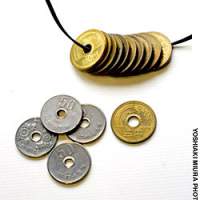Dear Alice,
I never saw a coin with a hole in the middle of it until I came to Japan, so I'm totally fascinated by the 5-yen and 50-yen coins. I even send them as gifts to friends back home, sometimes strung on chains as jewelry. However, no one I've met has been able to explain to me why those holes are there. What the heck is the story on Japan's holey coins?
Sharon T., Kagoshima
Dear Sharon,
I gather you're not from Papua New Guinea, Denmark or the Philippines, among the few nations other than Japan that still have coins with holes in the center. There used to be more because coins with holes were harder to counterfeit and cheaper to make (because you don't need as much metal for a coin with a hole). But with improvements in minting technology, many countries decided that the cost of producing the hole outweighed the advantages.
Fortunately for you and other aficionados of center-free coins, Japan has no plans to eliminate the holes in the 5- and 50-yen coins, according to an official at the Bank of Japan. The main rationale for keeping them, he said, is that the holes make it easy to distinguish those coins from others, particularly for people with visual impairments. That's a good reason, but I do wonder if Japanese are simply attached to the idea of coins with holes. After all, they've had them for a very long time. Round about 1,300 years, in fact.
I have to tread carefully here because there's some controversy about which was the first coin minted in Japan. Some scholars will tell you it's the Wado Kaichin, a copper coin generally dated to 708, while others will put their money solidly on the Fuhonsen, a bronze coin made earlier but not widely circulated. For the purposes of this discussion, it's enough for us to know that both of these early Japanese coins had holes. But the holes were square and served a very specific purpose.
Like Chinese coins of that period, on which they were surely modeled, the earliest coins in Japan were round and about 2.5 cm in diameter (roughly the size of today's 500-yen coin). There were produced, about a hundred at a time, in a mold with parallel troughs that funneled molten metal into the round sections that formed the coins. When the metal cooled, you had what looked like a money tree. The coins had to be broken off from the branches, leaving you with a rough stub, which (should you have a need to wow someone with your command of exceedingly obscure vocabulary) is called an ibari. Removing the stubs would be a lot of work if you had to file each coin one by one, but some clever person figured out that if you made the coins with square holes, you could skewer a whole line of them onto a square stick to hold them in place while you filed them all together.
Over the following centuries, Japanese coins were made in all sorts of shapes and sizes, including the enormous Tensho Oban, a gold oval first minted in 1588 that weighs in at 165 grams that's as heavy as 34 of today's 100-yen coins, by my kitchen scale. The Oban was a solid coin, but through most of Japan's history, at least some of the coins in use had holes. In the Tokugawa Period, there was a holed coin that merchants would string together for convenience and a financial premium. A bundle of 96 traded for the same value as 100 loose.
The first modern Japanese coin made with a hole was the 5-sen coin, released in 1917. (Until 1954, the yen was divided into 100 sen). The brass 5-yen coin you probably have in your pocket was first minted in 1959, while the current 50-yen coin, made from an alloy called cupronickel, has been around since 1967. There was an earlier all-nickel version, first issued in 1959 and still accepted today, but now rarely seen.
Say, wouldn't those make neat Christmas presents, if you can get a hole ... excuse me, a hold of them?



















With your current subscription plan you can comment on stories. However, before writing your first comment, please create a display name in the Profile section of your subscriber account page.